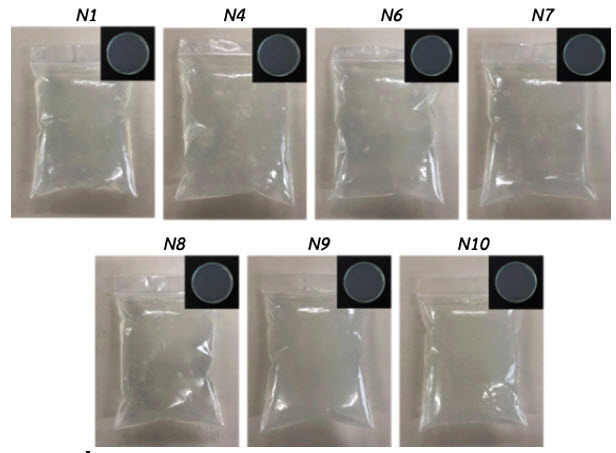แผ่นเจลประดิษฐ์จากแป้งมันสำปะหลังสำหรับการประคบร้อน–เย็น
Main Article Content
Abstract
Pattira Suktanarak and Benthiwa Surasartpisal
รับบทความ: 10 ธันวาคม 2563; แก้ไขบทความ: 19 มีนาคม 2564; ยอมรับตีพิมพ์: 5 พฤษภาคม 2564; ตีพิมพ์ออนไลน์: 3 ธันวาคม 2564
บทคัดย่อ
งานวิจัยนี้มีวัตถุประสงค์เพื่อพัฒนานวัตกรรมแผ่นเจลจากวัสดุพอลิเมอร์ชีวภาพสำหรับการประคบร้อน–เย็น โดยใช้แป้งมันสำปะหลังเป็นสารก่อเจลร่วมกับสารเติมแต่งกลีเซอรีนและบอแรกซ์ โดยศึกษาผลของกลีเซอรีนต่อการลดการแข็งตัวของเจลที่อุณหภูมิต่ำ และผลของบอแรกซ์ต่อการคงสภาพเจลด้วยการวิเคราะห์ลักษณะทางกายภาพและโครงสร้างทางเคมีเพื่อให้ได้สูตรเจลที่เหมาะสมสำหรับประคบบนผิวหนัง และนำมาศึกษาประสิทธิภาพในการเก็บกักอุณหภูมิเปรียบเทียบกับแผ่นเจลมาตรฐานในเกรดการแพทย์ ผลการทดลองพบว่า แผ่นเจลแป้งมันสำปะหลังสามารถเก็บกักอุณหภูมิให้อยู่ในช่วงของการบำบัดได้เป็นเวลาไม่ต่ำกว่า 15–20 นาที โดยประสิทธิภาพในการเก็บกักอุณหภูมิไม่แตกต่างจากแผ่นเจลมาตรฐานในกรณีของแผ่นเจลร้อนและแผ่นเจลเย็นที่เตรียมด้วยวิธีการแช่ในอ่างน้ำแข็ง (p ³ 0.05) ขณะที่แผ่นเจลเย็นที่เตรียมด้วยการแช่ในช่องแข็งและช่องเย็นสามารถเก็บกักอุณหภูมิได้นานกว่าแผ่นเจลมาตรฐาน แต่มีความไวต่อการเปลี่ยนแปลงอุณหภูมิที่ต่ำกว่า
คำสำคัญ: แผ่นเจลประคบร้อน–เย็น แป้งมันสำปะหลัง ประสิทธิภาพในการเก็บกักอุณหภูมิ
Abstract
This research aimed to develop a gel pack from biopolymer material for application in hot–cold compress. Our work employed cassava starch as a gelator cooperated with additive substances of glycerin and borak to improve the properties of starch gel. Our research ex-amined effect of glycerin on decreasing of gel change into the ice at low temperature, and effect of borax on stability enhancement of starch gel by analyzing physical characteristics as well as chemical structure to acquire an appropriate formula. Subsequently, the gel pack was investigated the efficiency of temperature control by comparing with standard gel in medical grade. The result showed that our starch gel can control temperature in range of clinical treatment for at least 15–20 min. In addition, efficiency of temperature control between starch gel and standard gel was no difference in case of hot gel as well as cold gel preparing in ice bath (p > 0.05). On the other hand, our cold gel prepared by freezing and cold storage exhibited a performance of temperature control higher than standard gel, but it was lower sensitivity to temperature.
Keywords: Hot–cold gel pack, Cassava starch, Efficiency of temperature control
Downloads
Article Details

This work is licensed under a Creative Commons Attribution-NonCommercial 4.0 International License.
References
Adamu, A. D., Jikan, S. S., Talip, B. H. A., Badarulzaman, N. A., and Yahaya, S. (2017). Effect of glycerol on the properties of tapioca starch film. Materials Science Forum 888: 239–243.
Aghazadeh, M., Karim, R., Abdul Rahman, R., Sultan, M. T., Paykary, M., and Johnson, S. (2018). Effect of glycerol on the physicochemical properties of cereal starch films. Czech Journal of Food Sciences 36(5): 403–409.
Dawam Abdu, A. H., Pudjirahar, S., Karina, M., Dwi Putri, O., and Fauziyyah, R. H. (2019). Fabrication and characterization of sweet potato starch–based bioplastics plasticized with glycerol. Journal of Biological Sci-ences 19: 57–64.
Eamchunprathip, S., and Tepapal, T. (2017). Effects of cold compression with self–efficacy on the pain and recovery among patients received open reduction internal fixation of femur. Nursing Journal 44(1): 39–49.
Eungapithum, N., Parisunyakul, S., and Sansiriphun, N. (2012). Effect of cold and heat compression on labor pain among primiparous mothers. Nursing Journal 39(4): 46–58.
Gramann, P., Cruz, J., Grewell, D., Montablo–Lomboy, M., and Wang, T. (2013). Effects of glycerin antifreeze on CPVC. 2013 Society of Plastic Engineers (SPE) ANTEC conference (pp. 1979–1984). Cincinnati, Ohio: Agricultural and Biosystems Engineer-ing, Food Science and Human Nutrition.
Ismail, H., Irani, M., and Ahmad, Z. (2013). Starch–based hydrogels: Present status and applications. International Journal of Polymeric Materials 62(7): 411–420.
Jaiban, S., Ruangpuk, S., and Saetang, N. (2016). The suitability of time for applied hot pack, Physiotherapy department, Hua Hin Hospital. Hua Hin Sook Jai Klai Kangwon Journal 1(2): 66–77.
Kaewfu, J. (2019). Effect of cold pack appli-cations on chemotherapy–induced injuries of blood vessels. Journal of Health Science 28(5): 139–146.
Kongphet, C., and Paneeya, J. (2011). The effect of cold gel pack compression on minimizing postoperative pain in eyelid surgery. Kuakarun Journal of Nursing 18(1): 67–79. (in Thai)
Lane, L. B. (1925). Freezing points of glycerol and its aqueous solutions. Industrial & Engineering Chemistry 17(9): 924.
Leurcharusmee, P., Nusupa, W., Lapisatepun, W., and Chawachart, C. (2017). Reduction of pain on injection from propofol by pretreatment with cold pack: a randomized controlled trial. Thai Journal of Anes-thesiology 43(3): 214–223. (in Thai)
Maitra, J., and Shukla, V. K. (2014). Cross–linking in hydrogels – A review. American Journal of Polymer Science 4(2): 25–31.
Mohamed, R., Mohd, N., Nurazzi, N., Siti Ais-yah, M. I., and Mohd Fauzi, F. (2017). Swelling and tensile properties of starch glycerol system with various crosslinking agents. IOP Conference Series: Materials Science and Engineering 223: 1–7.
Ngamtura, T., Chaiamit, K., Jantila, R., Khanchai, K., Deesuya, J., and Saethao, S. (2018). Cold compression first aid equipment: "Treena cold/hot pack". Journal of Health Science 27(1): 144–155.
Phadungchai, E., Kasiyaphat, A., and Silalertdejkul, S. (2015). The effects of endurance and high–intensity interval training on energy expenditure and body composition on dragon boat rowers. National and International Conference Interdisciplinary Research for Local Development Sustainability (pp. 241–251). Nakhon Sa-wan, Thailand: Nakhon Sawan Rajabhat University.
Riedo, C., Caldera, F., Poli, T., and Chiantore, O. (2015). Poly(vinylalcohol)–borate hydrogels with improved features for the cleaning of cultural heritage surfaces. Heritage Science 3(1): 23.
Samokham, N., and Sitilertpisan, P. (2016). Effect of dynamic core stability exercise on physical performance in male dragon boat paddlers. Bulletin of Chiang Mai Associated Medical Science 49(1): 146–154. (in Thai)
Subrahmanyam, P. (2012). Design and development of guar gum and borax cross–linked guar gum matrix tablets of theophylline for colon specific drug. Journal of Chemical and Pharmaceutical Research 4(2): 1052–1060.
Susawaengsup, C., Phuntulee, S., Wungkawan, N., and Sinnarong, N. (2020). Hom herb product development for reducing fever of upland community in Phrae province. Journal of Research Unit on Science, Technology and Environment for Learning 11(1): 66–82. (in Thai)
Tanan, W., and Saengsuwan, S. (2014). Super Absorbent polymer: synthesis, characterization, and applications. Journal of Science and Technology, Ubon Ratchathani University 16(2): 63–81. (in Thai)
Thaweethamcharoen, T. (2010). Outcomes and cost minimization between siriraj cold hot pack and the innovator product. Siriraj Medical Journal 62(5): 211–214.
Theerasopon, P., Panngam, N., and Hatkaew, N. (2016). The innovation of invented gal pad for use in health promotion and nur-sing therapeutic. Journal of Prapokklao Nursing College 27(2): 65–77. (in Thai)
Thepphabutra, A., and Subbalekha, K. (2016). Satisfaction of oral surgical patients with cold compression using temperature–maintaining gel. Thai Red Cross Nursing Journal 9(2): 119–131 (in Thai)
Thombare, N., Jha, U., Mishra, S., and Siddiqui, M. Z. (2017). Borax cross–linked guar gum hydrogels as potential adsorbents for water purification. Carbohydrate Polymers 168: 274–281.
